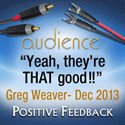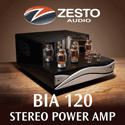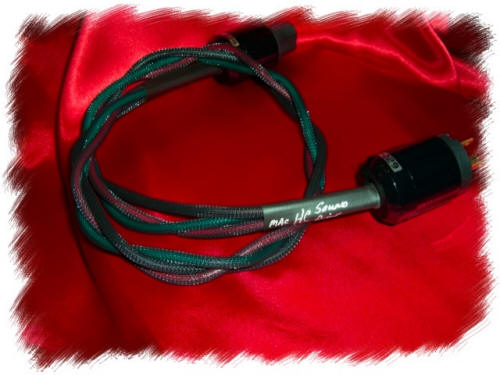|
|
You are reading the older HTML site
Positive Feedback ISSUE 75
rite audio cables HC Sound Pipe Power Cords - Even Cheapskates Deserve Good Sound as reviewed by Tom Gibbs
Three years ago when a massive lightning strike destroyed just about everything electronic in my home, I decided that I needed to make lemonade from the lemons life had just given me, and set out to build a relatively high-end oriented system on a really tight budget. Amazingly enough, with electronics from Emotiva, High Resolution Technologies and Luminous Audio, and a speaker/sub complement from Zu Audio and REL, I've achieved performance that I feel rivals systems costing many times their relatively meager price. And the ease and convenience of computer-based audio makes listening so effortless and enjoyable, and affords such musicality and realism to digital sources that I now spend way too much time actually listening to music, and virtually no time engaged in the sort of equipment envy that so occupied my prior life. Now, don't get me wrong—I still enjoy the opportunities that I often have to explore the glories of new hardware, especially when it brings better sound to more of us at affordable and reasonable prices. But I get a great deal of pleasure from my current system, and it leaves me wanting for very little else—most of the time. The joy of good cables Now, to a great extent, I've totally gone on the cheap here—but for the sake of full disclosure, I must come clean—only some of my cables are of the really cheap variety. And that's not because I downplay the role of well-constructed cables in any system—I just don't believe that their cost should rival or exceed the cost of other system components. My current system configuration is relatively straightforward, with very few cables involved. The DH Labs Silver Sonic USB cable that connects my PC to my HRT Music Streamer HD DAC retails for around $80—and with the exception of my speaker cables, exceeds the cost of the remaining Monoprice XLR's combined. In a balanced system, I firmly believe that transmission of the balanced signal is paramount, but less dependent on cable quality than single-ended cables in other connection applications. A 25-foot run of the Monoprice cable leaves the balanced outs of the Streamer HD and runs to my Luminous Audio Axiom passive pre, which in turn feeds another 6-foot run of the balanced Monoprice cable to the inputs of my Emotiva XPA-2 amplifier. Now the MG Audio Planus II speaker cables that run (8 feet) from the Emotiva XPA-2 to my Zu Audio Omens retail for about $1200—that's a hefty chunk of my overall system value, but you'll have to trust me on this one—worth every penny! The REL uses its supplied proprietary cable to derive the signal from the speaker connections on the Emotiva amp. Only two of the components in the chain actually require electricity—the Emotiva amp and the REL sub. And while I don't want to downplay the importance of cables in any system, for whatever reason, I've never tested an aftermarket power cable in any system I've ever owned, regardless of price. It took a great leap of faith to eventually employ the MG Audio speaker cables full-time—they're the single most expensive component in the current system! And in my extended overall system that includes an Acurus RL-11 pre and Rega table, most of the single-ended cables in the system are from Audioquest—holdovers from a previous system that at the time had a more generous budget. Anyway, and quite seriously—spending so much of my recent time listening to and enjoying the music—I'm not really over-analyzing my system components looking for weaknesses. But I do have to admit that despite my ongoing love affair with the Emotiva XPA-2, I've always been a little underwhelmed by the stock power cord that came with the amp. It just doesn't seem to fit properly—especially at the amp end of the cord. What to do—especially when you're as generally tight as I am—I spent a fair amount of time looking at old issues of the Audio Advisor catalog, thinking about going with a cheap mainstream cable along the lines of a Pangea, etc., and I wanted to keep it under $100. About that time, I happened to see a thread on the Audio Asylum blog exploring inexpensive power cables, and there were a number of positive recommendations for cables from Rite Audio Cables (RAC), run by Steve Hallick out of Myrtle Beach, South Carolina. His cables are all hand-built to order, and a three-foot HC power cord (including shipping) came to only $67—this became a complete no-brainer for me! Listening Tests From the point when Steve received my order, it was processed and shipped in less than a week. About that same time, my six-year-old granddaughter showed up for a two week visit, and I was also coincidentally at the tail end of getting over a miserable summer cold which came with a bonus inner-ear infection which left me essentially deaf for about six weeks. Now, my granddaughter is not exactly what I'd call high maintenance, but her presence was not exactly conducive to extended critical listening. So when the RAC cord showed up, I basically plugged it into the Emotiva XPA-2 (which remains powered on at all times) and let it burn in for the next two weeks. By the way, the fit and finish of Steve's cable is absolutely out of sight—I couldn't believe how firmly the cable fit at the amplifier end—it almost clicked into place when inserted. The connectors on the base model are made by Marinco and are really quite nice, but Steve offers an upgrade to Furutech termination for an upcharge if so desired. The three-foot length I ordered is unbelievably flexible, and offered no problems in terms of making connections at either end. This actually surprised me, because the individual cables are 10 AWG, with an effective overall gauge of 5 AWG. The cables are presented in a twisted braid, with really attractive jackets covering the individual strands—strictly on looks alone, I was immediately impressed with the quality of construction, and already felt better about my system's street cred. But the real proof would be how—and if—they impacted the overall sound.
I had the good fortune to have several days uninterrupted recently, where I could listen late into the evening or at any point during the day at any volume level, but right out of the gate I chose some mostly acoustic material with female vocals to hopefully help gauge the effectiveness of the RAC HC power cable. The first thing I noticed is that the music emerged from a blacker background than with the stock cord—the effect was not at all subtle. I immediately started cranking the volume closer to what I'd consider reference levels—I also noticed that the bass performance was consistently firmer on any selection I chose from my music server. The music played with an ease that literally floored me and totally impressed the hell out of me—I was expecting a subtle change here—if anything. I'd almost have been completely happy with the improved fit and stylish look the RAC HC gave my amp over the stock cord—I really wasn't expecting the level of overall improvement. I could list countless examples of improvement in imaging, realism and improved dynamic range, and trust me—over a three day period I threw just about everything at it. The Zu Omens are crossoverless and very revealing, and I have the REL sub set so that it only adds the lowest octave to the Zus running full range—you can switch the sub in and out and easily determine that the meaningful improvements to the bass content are happening at the sweet spot the Zus are operating in. In conclusion Steve Hallick was genuinely a pleasure to deal with, and his product and pricing can't be beat. I understand that he also builds cords of various configurations that a very highly thought of manufacturer offers as their stock cord. His entry-level power cord took my already excellent amplifier to the next level of power and realism—now I want to get one for that REL sub! I can't give a recommendation high enough—thanks to Steve and to everyone on the 'net who turned me on to his product! As an FYI, the RAC website is pretty bare-bones—if you have any serious questions, better to email him directly to get any information or particulars on pricing or options you might need. Hey, and they come with a 30-day trial, so you can judge for yourself in your own system. Tom Gibbs
RAC
HC Sound Pipe 3' Power Cord
Rite
Audio Cables
|










